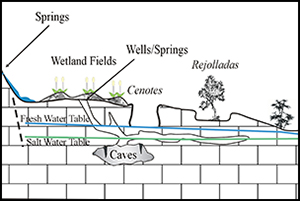Crossref Citations
This article has been cited by the following publications. This list is generated based on data provided by
Crossref.
Beach, Timothy
2016.
Climate change and archaeology in Mesoamerica.
Global and Planetary Change,
Vol. 138,
Issue. ,
p.
1.
Luzzadder‐Beach, Sheryl
Beach, Timothy
Garrison, Thomas
Houston, Stephen
Doyle, James
Román, Edwin
Bozarth, Steven
Terry, Richard
Krause, Samantha
and
Flood, Jonathan
2017.
Paleoecology and Geoarchaeology at El Palmar and the El Zotz Region, Guatemala.
Geoarchaeology,
Vol. 32,
Issue. 1,
p.
90.
Halperin, Christina T.
2017.
Anthropological Archaeology in 2016: Cooperation and Collaborations in Archaeological Research and Practice.
American Anthropologist,
Vol. 119,
Issue. 2,
p.
284.
Smyth, Michael P.
Dunning, Nicholas P.
Weaver, Eric M.
van Beynen, Philip
and
Zapata, David Ortegón
2017.
The perfect storm: climate change and ancient Maya response in the Puuc Hills region of Yucatán.
Antiquity,
Vol. 91,
Issue. 356,
p.
490.
Cook, D.E.
Beach, T.
and
Demarest, A.A.
2017.
Soil and slaughter: a geoarchaeological record of the ancient Maya from Cancuén, Guatemala.
Journal of Archaeological Science: Reports,
Vol. 15,
Issue. ,
p.
330.
Beach, Timothy
Luzzadder-Beach, Sheryl
Cook, Duncan
Krause, Samantha
Doyle, Colin
Eshleman, Sara
Wells, Greta
Dunning, Nicholas
Brennan, Michael L.
Brokaw, Nicholas
Cortes-Rincon, Marisol
Hammond, Gail
Terry, Richard
Trein, Debora
and
Ward, Sheila
2018.
Stability and instability on Maya Lowlands tropical hillslope soils.
Geomorphology,
Vol. 305,
Issue. ,
p.
185.
Beach, Tim
Ulmer, Austin
Cook, Duncan
Brennan, Michael L.
Luzzadder-Beach, Sheryl
Doyle, Colin
Eshleman, Sara
Krause, Samantha
Cortes-Rincon, Marisol
and
Terry, Richard
2018.
Geoarchaeology and tropical forest soil catenas of northwestern Belize.
Quaternary International,
Vol. 463,
Issue. ,
p.
198.
Giácoman‐Vallejos, Germán
Lizarraga‐Castro, Irma
Ponce‐Caballero, Carmen
González‐Sánchez, Avel
and
Hernández‐Núñez, Emanuel
2018.
Presence of DDT and Lindane in a Karstic Groundwater Aquifer in Yucatan, Mexico.
Groundwater Monitoring & Remediation,
Vol. 38,
Issue. 2,
p.
68.
Krause, Samantha
Beach, Timothy
Luzzadder-Beach, Sheryl
Cook, Duncan
Islebe, Gerald
Palacios-Fest, Manuel R.
Eshleman, Sara
Doyle, Colin
and
Guderjan, Thomas H.
2019.
Wetland geomorphology and paleoecology near Akab Muclil, Rio Bravo floodplain of the Belize coastal plain.
Geomorphology,
Vol. 331,
Issue. ,
p.
146.
Beach, Timothy
Luzzadder-Beach, Sheryl
and
Dunning, Nicholas P.
2019.
Biological Extinction.
p.
138.
Dunning, Nicholas P.
Anaya Hernández, Armando
Beach, Timothy
Carr, Christopher
Griffin, Robert
Jones, John G.
Lentz, David L.
Luzzadder-Beach, Sheryl
Reese-Taylor, Kathryn
and
Šprajc, Ivan
2019.
Margin for error: Anthropogenic geomorphology of Bajo edges in the Maya Lowlands.
Geomorphology,
Vol. 331,
Issue. ,
p.
127.
Krause, Samantha
Beach, Timothy
Luzzadder-Beach, Sheryl
Guderjan, Thomas H.
Valdez, Fred
Eshleman, Sara
Doyle, Colin
and
Bozarth, Steven R.
2019.
Ancient Maya wetland management in two watersheds in Belize: Soils, water, and paleoenvironmental change.
Quaternary International,
Vol. 502,
Issue. ,
p.
280.
Grauer, Kacey C
2020.
Active environments: Relational ontologies of landscape at the ancient Maya city of Aventura, Belize.
Journal of Social Archaeology,
Vol. 20,
Issue. 1,
p.
74.
Collard, Mark
Carleton, W. Christopher
Campbell, David A.
and
Biehl, Peter F.
2021.
Rainfall, temperature, and Classic Maya conflict: A comparison of hypotheses using Bayesian time-series analysis.
PLOS ONE,
Vol. 16,
Issue. 7,
p.
e0253043.
Stoner, Wesley D.
Stark, Barbara L.
VanDerwarker, Amber
and
Urquhart, Kyle R.
2021.
Between land and water: Hydraulic engineering in the Tlalixcoyan basin, Veracruz, Mexico.
Journal of Anthropological Archaeology,
Vol. 61,
Issue. ,
p.
101264.
Luzzadder-Beach, Sheryl
Beach, Timothy P.
and
Dunning, Nicholas P.
2021.
Wetland Farming and the Early Anthropocene: Globally Upscaling from the Maya Lowlands with LiDAR and Multiproxy Verification.
Annals of the American Association of Geographers,
Vol. 111,
Issue. 3,
p.
795.
Penny, Dan
and
Beach, Timothy P.
2021.
Historical socioecological transformations in the global tropics as an Anthropocene analogue.
Proceedings of the National Academy of Sciences,
Vol. 118,
Issue. 40,
Sekhon, Natasha
Beach, Tim
Krause, Samantha
and
Eshleman, Sara
2021.
Understanding climate trends in Central America through practical problem-based learning.
Journal of Geography in Higher Education,
Vol. 45,
Issue. 2,
p.
298.
Cook, Duncan E.
Beach, Timothy P.
Luzzadder-Beach, Sheryl
Dunning, Nicholas P.
and
Smith, Byron A.
2022.
Treatise on Geomorphology.
p.
504.
Lentz, David L.
Hamilton, Trinity L.
Dunning, Nicholas P.
Jones, John G.
Reese-Taylor, Kathryn
Anaya Hernández, Armando
Walker, Debra S.
Tepe, Eric J.
Carr, Christopher
Brewer, Jeff L.
Ruhl, Thomas
Meyers, Stephanie A.
Vazquez, Mariana
Golden, Alex
and
Weiss, Alison A.
2022.
Paleoecological Studies at the Ancient Maya Center of Yaxnohcah Using Analyses of Pollen, Environmental DNA, and Plant Macroremains.
Frontiers in Ecology and Evolution,
Vol. 10,
Issue. ,
